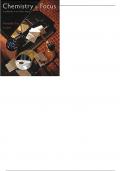Exam (elaborations)
Test Bank for Chemistry in Focus A Molecular View of Our World 5th Edition by Nivaldo
- Course
- Institution
Chapter 1—Molecular Reasons MULTIPLE CHOICE 1. Which of these is the best definition of matter? a. The pull of gravity on an object. b. Anything that has weight and volume. c. Anything that has mass and occupies space. d. Anything that is directly proportional to weight. e. The measure of...
[Show more]



